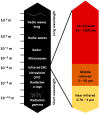Therapeutic Potential of Infrared and Related Light Therapies in Metabolic Diseases
- PMID: 40507946
- PMCID: PMC12154360
- DOI: 10.3390/ijms26115134
Therapeutic Potential of Infrared and Related Light Therapies in Metabolic Diseases
Abstract
Infrared and related light therapies are gaining increasing interest due to their potential therapeutic properties in treating various health conditions, particularly metabolic diseases such as insulin resistance and type 2 diabetes. These diseases often coexist with dyslipidemia, obesity, non-alcoholic fatty liver disease, and cardiovascular complications. This review paper analyzes the impact, primarily of far-infrared light therapy (FIR), on improving endothelial function, reducing oxidative stress, and modulating inflammatory responses-key factors in metabolic diseases. Preliminary studies suggest that FIR may improve blood circulation, increase the secretion of VEGF, and enhance insulin sensitivity by alleviating inflammatory states and oxidative damage commonly associated with these diseases. In addition, FIR has been associated with potential benefits in blood pressure regulation and lipid metabolism, which could contribute to reduced cardiovascular risk. However, it is important to acknowledge that most current evidence is derived from preclinical models and small-scale clinical trials, limiting direct applicability to broader patient populations. Moreover, significant variability exists in exposure parameters and treatment protocols across studies. While FIR therapy holds potential as a complementary approach to the conventional management of metabolic diseases, careful monitoring is essential to mitigate potential adverse effects. Further well-designed, large-scale clinical trials are necessary to validate the therapeutic efficacy, optimize treatment parameters, and comprehensively assess the safety profile of FIR interventions in metabolic health.
Keywords: cardiovascular health; far-infrared light therapy (FIR); inflammation; metabolic diseases; non-pharmacological therapies; oxidative stress.
Conflict of interest statement
The authors declare no conflicts of interest.
Figures





Similar articles
-
Far-infrared therapy induces the nuclear translocation of PLZF which inhibits VEGF-induced proliferation in human umbilical vein endothelial cells.PLoS One. 2012;7(1):e30674. doi: 10.1371/journal.pone.0030674. Epub 2012 Jan 23. PLoS One. 2012. PMID: 22292015 Free PMC article.
-
Far-infrared radiation alleviates cisplatin-induced vascular damage and impaired circulation via activation of HIF-1α.Cancer Sci. 2022 Jun;113(6):2194-2206. doi: 10.1111/cas.15371. Epub 2022 Apr 20. Cancer Sci. 2022. PMID: 35411640 Free PMC article.
-
Far-infrared radiation and its therapeutic parameters: A superior alternative for future regenerative medicine?Pharmacol Res. 2024 Oct;208:107349. doi: 10.1016/j.phrs.2024.107349. Epub 2024 Aug 14. Pharmacol Res. 2024. PMID: 39151679 Review.
-
Graphene-Based Far-Infrared Therapy Promotes Adipose Tissue Thermogenesis and UCP1 Activation to Combat Obesity in Mice.Int J Mol Sci. 2025 Feb 28;26(5):2225. doi: 10.3390/ijms26052225. Int J Mol Sci. 2025. PMID: 40076847 Free PMC article.
-
Dietary glycation compounds - implications for human health.Crit Rev Toxicol. 2024 Sep;54(8):485-617. doi: 10.1080/10408444.2024.2362985. Epub 2024 Aug 16. Crit Rev Toxicol. 2024. PMID: 39150724
Cited by
-
Improvement of Blood Flow and Epidermal Temperature in Cold Feet Using Far-Infrared Rays Emitted from Loess Balls Manufactured by Low-Temperature Wet Drying Method: A Randomized Trial.Biomedicines. 2025 Jul 18;13(7):1759. doi: 10.3390/biomedicines13071759. Biomedicines. 2025. PMID: 40722828 Free PMC article.
References
-
- Chew N., Ng C.H., Tan D.J.H., Kong G., Lin C.X., Chin Y.H., Foo R., Chan M., Muthiah M.D. Global Burden of Metabolic Diseases: Data from Global Burden of Disease 2000–2019. A Cosortium of Metabolic Disease. Eur. Heart J. 2023;44:ehac779.131. doi: 10.1093/eurheartj/ehac779.131. - DOI
-
- Ginsberg H.N., MacCallum P.R. The Obesity, Metabolic Syndrome, and Type 2 Diabetes Mellitus Pandemic: Part I. Increased Cardiovascular Disease Risk and the Importance of Atherogenic Dyslipidemia in Persons with the Metabolic Syndrome and Type 2 Diabetes Mellitus. J. Cardiometabolic Syndr. 2009;4:113–119. doi: 10.1111/j.1559-4572.2008.00044.x. - DOI - PMC - PubMed
-
- Miller S.J., Brown S. Overweight and Obesity. APhA OTC Nutr. Nutr. Suppl. 2024 doi: 10.21019/aphaotc-nutrition.obesity. - DOI
Publication types
MeSH terms
LinkOut - more resources
Full Text Sources
Medical

